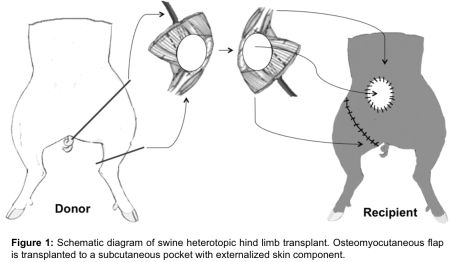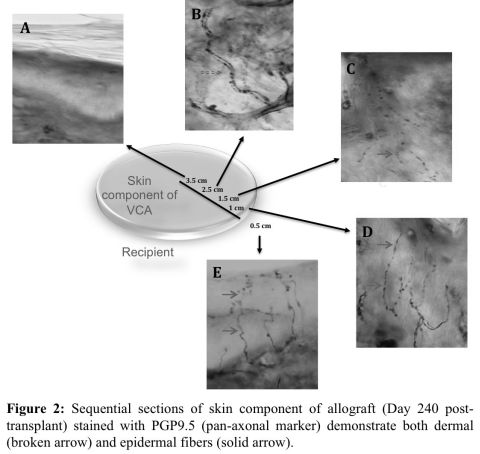Cutaneous Collateral Axonal Sprouting Re-Innervates the Skin Component and Restores Sensation of Denervated Swine Osteomyocutaneous Allografts
Plastic and Reconstructive Surgery, Johns Hopkins University, Baltimore
Neurology, Johns Hopkins University, Baltimore
Meeting: 2013 American Transplant Congress
Abstract number: A846
BACKGROUND: Reconstructive transplantation is a viable treatment option for select patients with devastating tissue loss. However, sensorimotor recovery is critical determinant of its overall success. Although the recovery of motor function has been studied extensively, the mechanisms of sensory re-innervation are not well established. Recent clinical reports of face transplants confirm progressive sensory improvement even in cases where optimal repair of sensory nerves was not possible. This can be attributed to slow and steady axonal sprouting.
METHODS: Denervated osteomyocutaneous allografts (n=8) from MHC-defined MGH swine were performed [Fig 1]. Serial sections were immunostained against a pan-axonal marker (PGP9.5) to visualize regenerating axonal structures in the dermis and epidermis. Axonal sprouting rates were quantified using established stereology techniques.
RESULTS: Axonal sprouts from native skin grew into the denervated skin component of the graft along the dermal-epidermal junction in all allografts. 8 months following transplant, dermal fibers were visualized 2.5 cm from the margin (rate of regeneration 0.1 mm/day) [Fig 2]. All animals had pinprick sensation in the peripheral allograft skin within 3 months post-transplant.
CONCLUSION: This is the first large animal model to show that axonal sprouting can extend along dermal-epidermal junction to provide sensory re-innervation to the skin component of reconstructive transplants. Return of normal sensation can initiate defense mechanisms and aid in cortical re-integration of vascularized composite allografts.


To cite this abstract in AMA style:
Ibrahim Z, Christensen J, Lin C, Sarhane K, Hauer P, Polydefkis M, Schneeberger S, Cooney D, Sacks J, Lee W, Brandacher G. Cutaneous Collateral Axonal Sprouting Re-Innervates the Skin Component and Restores Sensation of Denervated Swine Osteomyocutaneous Allografts [abstract]. Am J Transplant. 2013; 13 (suppl 5). https://atcmeetingabstracts.com/abstract/cutaneous-collateral-axonal-sprouting-re-innervates-the-skin-component-and-restores-sensation-of-denervated-swine-osteomyocutaneous-allografts/. Accessed December 13, 2025.« Back to 2013 American Transplant Congress
